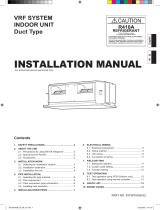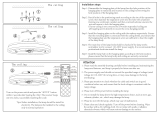
En-2
1. SAFETY PRECAUTIONS
• Be sure to read this Manual thoroughly before installation.
• The warnings and precautions indicated in this Manual con-
tain important information pertaining to your safety. Be sure
to observe them.
• Hand this Manual, together with the Operating Manual, to
the customer. Request the customer to keep them on hand
for future use, such as for relocating or repairing the unit.
WARNING
Indicates a potentially or imminently
hazardous situation which, if not
avoided, could result in death or serious
injury.
Installation of this product must be done by experienced
service technicians or professional installers only in ac-
cordance with this manual. Installation by nonprofessional
or improper installation of the product may cause serious
accidents such as injury, water leakage, electric shock, or
fi re. If the product is installed in disregard of the instructions
in this manual, it will void the manufacturer’s warranty.
Do not turn on the power until all work has been completed.
Turning on the power before the work is completed can
cause serious accidents such as electric shock or fi re.
If refrigerant leaks when you are working, ventilate the area.
If the leaking refrigerant is exposed to a direct fl ame, it may
produce a toxic gas.
Do not use this equipment with air or any other unspeci-
fi ed refrigerant in the refrigerant lines. Excess pressure can
cause a rupture.
Installation must be performed in accordance with regula-
tions, codes, or standards for electrical wiring and equip-
ment in each country, region, or the installation place.
Do not touch the fi ns of the heat exchanger. Touching the
heat exchanger fi ns could result in damage to the fi ns or
personal injury such as skin rupture.
This appliance is not intended for use by persons (including
children) with reduced physical, sensory or mental capabili-
ties, or lack of experience and knowledge, unless they have
been given supervision or instruction concerning use of the
appliance by a person responsible for their safety. Children
should be supervised to ensure that they do not play with
the appliance.
CAUTION
Indicates a potentially hazardous situa-
tion that may result in minor or moder-
ate injury or damage to property.
Read carefully all safety information written in this manual
before you install or use the air conditioner.
Install the product by following local codes and regulations
in force at the place of installation, and the instructions
provided by the manufacturer.
This product is part of a set constituting an air conditioner.
The product must not be installed alone or be installed with
non-authorized device by the manufacturer.
Always use a separate power supply line protected by a cir-
cuit breaker operating on all wires with a distance between
contact of 3 mm for this product.
To protect the persons, earth (ground) the product correctly,
and use the power cable combined with an Earth Leakage
Circuit Breaker (ELCB).
The product is not explosion proof, and therefore should
not be installed in explosive atmosphere.
To avoid getting an electric shock, never touch the electrical
components soon after the power supply has been turned
off. After turning off the power, always wait 5 minutes or
more before you touch the electrical components.
This product contains no user-serviceable parts. Always
consult experienced service technicians for repairing.
When moving or relocating the air conditioner, consult
experienced service technicians for disconnection and
reinstallation of the product.
Do not place any other electrical products or household
belongings under the product. Condensation dripping from
the product might get them wet, and may cause damage or
malfunction of the property.
2. ABOUT THE UNIT
2.1. Precautions for using R410A
refrigerant
WARNING
• Do not introduce any substance other than the prescribed
refrigerant into the refrigeration cycle. If air enters the
refrigeration cycle, the pressure in the refrigeration cycle
will become abnormally high and cause the piping to
rupture.
• If there is a refrigerant leak, make sure that it does
not exceed the concentration limit. If a refrigerant leak
exceeds the concentration limit, it can lead to accidents
such as oxygen starvation.
• Do not touch refrigerant that has leaked from the refriger-
ant pipe connections or other area. Touching the refriger-
ant directly can cause frostbite.
• If a refrigerant leak occurs during operation, immediately
vacate the premises and thoroughly ventilate the area. If
the refrigerant comes in contact with a fl ame, it produces
a toxic gas.
2.2. Special tools for R410A
WARNING
• To install a unit that uses R410A refrigerant, use dedi-
cated tools and piping materials that have been manufac-
tured specifi cally for R410A use. Because the pressure
of R410A refrigerant is approximately 1.6 times higher
than the R22, failure to use dedicated piping material or
improper installation can cause rupture or injury.
Furthermore, it can cause serious accidents such as
water leakage, electric shock, or fi re.

















